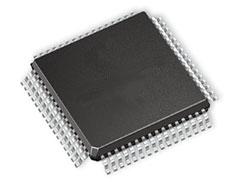Operating Temperature Range
:
Data Bus Width
: 8 bit
Program Memory Size
: 128 KB
On-Chip ADC
: Yes
Mounting Style
: SMD/SMT
Data RAM Size
: 4 KB
Core
: AVR
Package / Case
: TQFP-64
Operating Supply Voltage
: 4.5 V to 5.5 V
Processor Series
: ATMEGA128x
Maximum Clock Frequency
: 16 MHz
Pinout Description
DescriptionThe ATMEGA128-16AU is a low-power CMOS 8-bit microcontroller based on the AVR enhanced RISC architecture. By executing powerful instructions in a single clock cycle,the ATMEGA128-16AU achieves throughputs approaching 1 MIPS per MHz allowing the system designer to optimize power consumption versus processing speed.
The ATMEGA128-16AU provides the following features: 128K bytes of In-System Programmable Flash with Read-While-Write capabilities, 4K bytes EEPROM, 4K bytes SRAM, 53 general purpose I/O lines, 32 general purpose working registers, Real Time Counter (RTC), four flexible Timer/Counters with compare modes and PWM, 2 USARTs, a byte oriented Two-wire Serial Interface, an 8-channel, 10-bit ADC with optional differential input stage with programmable gain, programmable Watchdog Timer with Internal Oscillator,an SPI serial port, IEEE std. 1149.1 compliant JTAG test interface, also used for accessing the On-chip Debug system and programming and six software selectable power saving modes. The Idle mode stops the CPU while allowing the SRAM,Timer/Counters, SPI port, and interrupt system to continue functioning. The Powerdown mode saves the register contents but freezes the Oscillator, disabling all other chip functions until the next interrupt or Hardware Reset. In Power-save mode, the asynchronous timer continues to run, allowing the user to maintain a timer base while the rest of the device is sleeping. The ADC Noise Reduction mode stops the CPU and all I/O modules except Asynchronous Timer and ADC, to minimize switching noise during ADC conversions. In Standby mode, the Crystal/Resonator Oscillator is running while the rest of the device ATMEGA128-16AU is sleeping. This allows very fast start-up combined with low power consumption. In Extended Standby mode, both the main Oscillator and the Asynchronous Timer continue to run.
The ATMEGA128-16AU AVR is supported with a full suite of program and system development tools including: C compilers, macro assemblers, program debugger/simulators, in-circuit emulators, and evaluation kits.
Parameters: | Technical/Catalog Information | ATMEGA128-16AU |
| Vendor | Atmel |
| Category | Integrated Circuits (ICs) |
| Program Memory Size | 128K x 8 |
| RAM Size | 4K x 8 |
| Number of I /O | 53 |
| Package / Case | 64-TQFP |
| Speed | 16MHz |
| Controller Series | ATmega |
| Oscillator Type | Internal |
| Packaging | Tray |
| Program Memory Type | FLASH |
| EEPROM Size | 4K x 8 |
| Core Processor | AVR |
| Data Converters | A/D 8x10b |
| Core Size | 8-Bit |
| Operating Temperature | -40°C ~ 85°C |
| Connectivity | I²C, SPI, UART/USART |
| Peripherals | Brown-out Detect/Reset, POR, PWM, WDT |
| Voltage - Supply (Vcc/Vdd) | 4.5 V ~ 5.5 V |
| Lead Free Status | Lead Free |
| RoHS Status | RoHS Compliant |
| Other Names | ATMEGA128 16AU
ATMEGA12816AU
|

 ATmega128-16AU Data Sheet
ATmega128-16AU Data Sheet







